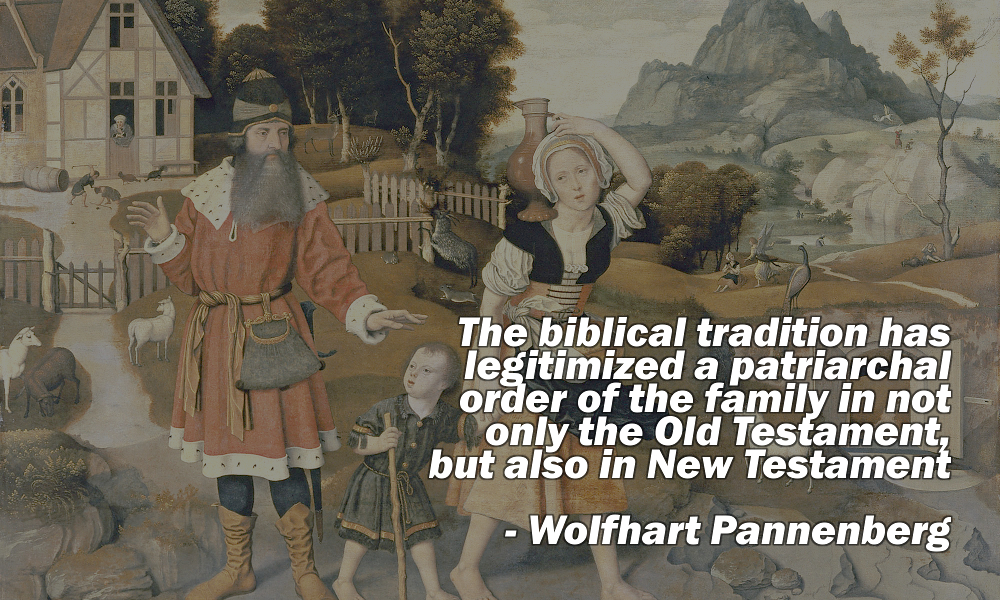In his famous book, Anthropology in Theological Perspective, Wolfhart Pannenberg says "that the biblical tradition has legitimized a patriarchal order of the family" in not only the Old Testament, but also in New Testament: cf. 1 Cor 14:34, Col 3:18, 1 Pet 3:1, Tit 2:5, etc. Pannenberg boldly believes that the Bible itself is to blame for the pathology of patriarchy! He believes that there are two parallel developments throughout the bible: the first establishes patriarchy and the second overthrows it.
Biblical Patriarchy is ultimately defeated by Jesus and the advancement of Christianity in the world. Pannenberg's dialectical approach has an advantage over the traditional complementarian and egaliatarian interpretations of these troubling patriarchal verses. The Complementarians wish to read these patriarchal verses with rose color glasses and affirm them cautiously in order to defend the bible from error. The Egalitarians disarm these troubling verses by contextualizing them away as artifacts of an ancient culture, or reinterpret them in a way contrary to their prima facie meaning. (There are even evangelicals today who wish to defend and affirm biblical patriarchy, but I will ignore them for now). Pannenberg's strength is that he is able to point his finger at these troubling verses and say biblical patriarchy is no longer justified after the death and resurrection of Jesus Christ, because Jesus has established a community of mutual love to which we may all submit ourselves.
I've divided Pannenberg's long quotation on biblical patriarchy from Anthropology in Theological Perspective into sections to provide commentary on what would otherwise had been a continuous selection of his book:
"It is in fact undeniable that the biblical tradition has legitimatized a patriarchal order of the family and, in particular the subordination of wife to husband as his possession (Ex 20:17). The Yahwist story of creation sees the relation of wife to husband as regulated by the divine words spoken at the end of the story of paradise: "He shall rule over you." The New Testament writings continue to reflect the Jewish organizations of the family and to call for the subordination of wife to husband (1 Cor 14:34; see Col 3:18; 1 Peter 3:1; Titus 2:5)."
Pannenberg, Wolfhart. Anthropology in Theological Perspective. Trans. Matthew J. O'Connell. Philadelphia: Westminster, 1985. 438-40. Print.
In the first chapters of the Bible, Pannenberg finds justification for patriarchy in the verse "He shall rule over you" (Gen 3:16). This same location in scripture (Gen 2-3) is frequently cited to prove that marriage has always been monogamously defined as "one man and one woman." If the sanctity of marriage is timelessly defined as such, then we inherit the burden of defending the holiness of patriarchy! In the cynical words of Paul, may it never be! Marriage is revealed as good (in Gen 2-2), yet the revelation is mixed with patriarchy that is not good and also is inseparable from it.
It is partially analogous to Jesus' Parable of the Wheat and Tares (Matt 13:24-30): the farmer sows 'patriarchal' weeds along with the wheat, and although the wheat is the intended harvest, the farmer is responsible for cultivating the weeds as well, and we are unable to grow wheat if we pull up the 'patriarchal' weeds, yet when the harvest is here the weeds are separated and burned. The analogy to the parable isn't perfect, but it helps explain how the patriarchal organizations of the family are established and affirmed by the Old Testament. Yes, patriarchy is justified by the bible, but it is not until the fullness of revelation appears in Jesus Christ that we are able to purge patriarchy from us, and then establish a mutual community of love that is free from patriarchy.
The "Patriarchs" and Kings of Israel were exemplars of patriarchy and instances of today's definition of marriage as "one man and one woman" is rare. If we are honest, the bible praises, and does not condemn, these holy men for their concubinage, bigamy, polygamy, divorce and desertion of women: Abraham with Hagar, Sara, and Keturah; Jacob with Rachel, Leah, Bilhah, and Zilpah; Moses with Zipporah and Keturah; King David with Abigal, Michal, Bathsheba, Abishag and many others; And of course the thousand wives and concubines of King Solomon, and Jephthah sacrificing virgins in household. The troubling verses that Pannenberg cites reminds us that these patriarchal examples were not limited to the Old Testament but were also in the New Testament as well (and I'll leave it as an exercise to the reader to understand why).
"At the same time, however, the basis for a breakthrough and for the elimination of patriarchal structures is to be found in early Christianity and, above all, in the behavior of Jesus himself. But the Old Testament recognized the possibility of conflict between obedience to God and loyalty to the patriarchally organized family. In such cases, obedience to God had to take precedence. Thus Abraham was summoned by God to leave his father's house (Gen 12:1). There is a saying of Jesus that points in the same direction: "If anyone comes to me and does not hate his own father and mother and wife and children and brothers and sisters, yes, and even his own life, he cannot be my disciple" (Luke 14:26)."
Ibid.
Only in the western modern world in the last century has Women's Right begun to be realized. Pannenberg gives all the credit to Jesus Christ and the work of early Christianity that has finally begun to be realized today. Pannenberg's remarkable insight into Luke 14:26 explains how Jesus defeated biblical patriarchy and liberates us from it when he observes that the "Patriarch" Abraham separated himself from the patriarchal familial structures of his father's Terah's house, and that we may understand this as a partial liberation from his old patriarchal "absolutizing of family loyalty."
"These and similar sayings of Jesus, however, are not directed against the patriarchal family structure in particular but first and foremost against the absolutizing of family loyalty as such. Obedience to God takes priority over family ties. But since this demand binds all human beings alike, it has consequences that in the name of God the Father shatter the patriarchal family order. This can be seen especially in Jesus' dealings with women. Even though the early Christian tradition was rather strongly prejudiced on the side of patriarchal views, it did at decisive points speak out against the neglect of woman in comparison with men, as, for example, when it emphasized the equality of men and women in Christ (Gal 3:28) and called married people to mutual love after the example of Christ (Eph 5:28ff)."
Ibid.
Pannenberg begins to explain how Jesus defeated biblical patriarchal by observing the way his relationships to women were superior to his received patriarchal structures. Jesus engages with women throughout his ministry and we see Jesus emphasizing and utilizing women in the same way as his male disciples throughout his ministry (cf. Elisabeth Moltmann-Wendel's The Women Around Jesus.)
Pannenberg believes that biblical patriarchy is replaced with a renewed relationship between men and women that he defines as "mutual love after the example of Christ". It is through the imitation of Christ, that the early Church was able to overcome the patriarchal ancient society. Pannenberg uses this brilliant insight to explain Jesus' statement about 'hating ones own family', by saying that this is a hatred of biblical patriarchal structures.
"These impulses were also at work in the subsequent history of Christianity. This is especially true of Jesus' condemnation of divorce, which Jewish law allowed husbands to declare unilaterally (Mark 10:2-12). By making divorce difficult, but also by requiring marital consent from both partners and abolishing the right that Roman law granted to the pater familias over the life and death of family members, the legislation of the early Byzantine emperors significantly improved the position of married women. We may see this legislation as paving the way for a conception of marriage as more of a partnership, even if it left untouched the basic patriarchal structure of the family, a structure that was indeed also based on the economic and political conditions of that age. In any case, in the light of those beginnings it is possible to see the dissolution of the patriarchal family structure, which resulted from political and economic changes in modern society, as an opportunity to reshape marriage and family in the spirit of the Christian idea of mutual love."
Ibid.
Pannenberg's ends with another excellent commentary on Jesus' prohibition of divorce. Today, many states have no fault divorce and divorce is very common, where both men and women often abandon their marriages. However, Pannenberg notes that in the Ancient Near East, divorce was a way for a husband to dispose of an unwanted spouse, and women did not have such rights. Jesus' prohibition of divorce means that the patriarch of the family was unable to dispense of one of his wives whenever he grew tired of her, in a time that the woman was otherwise helpless and at the husband's mercy. It's an excellent example of how our culture's perspective can deceive us when we compare it to Ancient Near East culture.
"It is essential for any such reshaping that marriage no longer be viewed from the standpoint of the family but, rather, the family from the standpoint of marriage. This means, first of all, that marriage, being a communion of love between partners, is an end in itself and does not need to be justified by any further purposes, not even the generation of a new life. Only if the community of marriage is understood as an end in itself can marriage serve as an exemplar of the human destination to that life in communion with others to which individual personhood owes its substance and cohesion. Marriage can represent the priority of the community over individuals because it embraces the entire life of the individuals in it. To that extent, individuals entering marriage surrender their isolated individuality."
Ibid.
In this final quote, Pannenberg states that Jesus and early Christianity has overthrown biblical patriarchy and replaced it with a definition of "being a communion of love between partners". No longer is marriage understood form patriarchal mandates, such as the demand that a husband and wife must bear children. Individuals enter marriage to obtain mutual love from others, and the same is true of community. When we enter into a community of faith, we submit and surrender to it as individuals, so that we may all mutually be loved by one another, as Christ loved us first. Only then, will we see Biblical Patriarchy defeated entirely! Only in modern times in the western world has Women's Rights begun to be realized, and this is a wonderful thing! We have also seen the widespread end of slavery and other forms of patriarchy as well. Deliverance was dimly preached before Jesus, and the abolition of Biblical Patriarchy was announced by Jesus, but only now after two millennia of the Church's labors has it finally begun to be realized.
Header Image Source: "Jan Mostaert - The Banishment of Hagar" by Jan Mostaert (circa 1475-1552/1553) - 1. Web Gallery of Art: Image Info about artwork2. Museo Thyssen-Bornemisza, Madrid. Licensed under Public Domain via Commons.




January 15th, 2017 - 08:00
YES, thank you for the quotations and explanations. But this wouldn’t have been possible only by religious means. The secularization has been necessary to empower the political laws which put quite an end to patriarchal practices in fact
January 16th, 2017 - 02:35
I agree with Antoine on the importance of the present culture forming our views of marriage. However, what I always appreciate about Pannenberg is that he puts the biblical tradition into a conversation and even debate. I think that preserves respect and even love for the biblical context within which we carry out our conversation today.
June 11th, 2017 - 15:26
It would seem to me that if functional gender differentiation gives way to a paired bond in community, then it is also true, though with different building blocks, that gender itself can be set aside, and then there is no reason why same-sex couples cannot enter into a loving community in like manner.
June 11th, 2017 - 17:37
I don’t believe that Pannenberg wrote much in support of gender fluidity or LGBTQIA. Stanley Grenz, one of his students wrote a book “Welcoming but not affirming” before many were talking about these issues. I don’t know how they would respond today. Thanks for commenting!